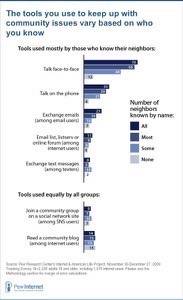The Pew Research Center’s Internet & American Life Project has released a report titled “Neighbors Online.” The report maintains that, although face-to-face communications and phone calls still take pride of place in local information gathering, online sources are making strides.

- 22% of all adults – 28% of Internet users – signed up to receive alerts about local issues via email or text messaging
- 20% of all adults – 27% of Internet users – used digital tools to talk to their neighbors and keep informed about community issues
For those who are still under the illusion that the Internet is the exclusive domain of hip-swiveling youth and tattooed roboticists, these numbers are shocking. In any context, they’re impressive. But they are dwarfed by the frequency by which neighbors chat over the metaphorical, not virtual, fence. Forty-six percent of Americans surveyed talked about community issues with their neighbors in person; 21% did so over the phone. Compared to these instances, Internet use is proportionate.

- 11% read a blog dealing with community issues
- 9% exchanged emails with neighbors about community issues and 5% say they belong to a community email listserv
- 4% communicated with neighbors by text messaging on cell phones
- 4% joined a social network site group connected to community issues
- 2% followed neighbors using Twitter
For anyone who has thought that no one knows their neighbors anymore (though they may make an exception for themselves), this is less true than one might think. Nineteen percent of those surveyed said that they knew the names of all of their neighbors, 24% said they knew most of them, and 29% knew some. Only 28% knew none of their neighbors’ names. Interestingly, Internet use makes no statistical difference to the likelihood of neighborhood familiarity.
So, what effect have online tools had on neighborhood interactions? Aaron Smith, research specialist at Pew and author of the report, said in an email they acted, in part, as a bridge.
“The biggest effect that online tools have had on neighborhood interactions is in providing an avenue for learning about and interacting on local issues to individuals who might not engage in these issues through more traditional means. People who are at a point in their lives where they might not be acquainted with their neighbors can still utilize online social networks or community blogs to learn about the issues facing their neighborhoods, and interact with people who are engaged in the same issues, even if they don’t know each other ‘personally.'”

It may be that, as much as our technology has developed, our needs and values haven’t changed so much as either the technological alarmists or the technological millenialists believe. When it comes to our children, our parents, our wives and husbands, perhaps that’s where we will always insist that technology serve us.
Fence photo by Orin Zebest





















